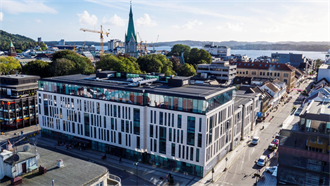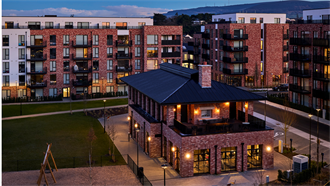What matters most to those in the real estate industry when it comes to a global societal vision? Experts from a range of sectors gave their views during PropertyEU's virtual roundtable on ESG hosted in early March.
Earlier this month, Property EU gathered together – virtually, of course – a group of leading real estate professionals to debate that most topical of subjects: how to put in place a meaningful and effective environmental, social and governance (ESG) strategy.
If anything, ESG strategies are even more important today than before the Covid-19 pandemic struck, so how did the panel define the various elements of their ESG strategies? How can their successes or failures be measured? And what impact are they having in the real world?
Kicking off the discussion, Dr Raphael Mertens, chief risk officer at Allianz Real Estate, said his organisation had taken five years to develop its strategy and set up the necessary measurement framework but that it was now ready to be executed. And while he emphasised that the social and governance elements were important, he added that Allianz had concluded that it could have the greatest impact when it came to environmental sustainability.
‘I think the main thing, at least for us, was really looking at the carbon footprint of our real estate,’ he said. ‘We think this should be the key priority. So, that’s really focusing on environmental impact, on energy efficiency and decarbonisation. That’s our focus in terms of whatever we buy, whatever we manage, whatever we refurbish. Now, whenever we talk to our tenants, to our business partners, that has to be put on the agenda.’
Natali Cooper, head of portfolio and asset management, Europe, at logistics developer and investment manager GLP, added: ‘We also develop real estate, so we have a great opportunity to respond positively to the climate emergency, with respect to the reduction of the carbon emissions produced through the construction phase.’
However, Cooper explained that GLP also wanted to take a broad view of what its ESG strategy could achieve – and warned that there was a danger in trying to tackle too many objectives and standards and therefore achieve too little. ‘We also took a very strong view that we wanted to be an ethical business and do the right thing for employees and for all our stakeholders, so that’s another key aspect we accounted for when setting up our ESG strategy,’ she said.
‘I think one of the complexities in ESG is that it is such a broad topic. You can delude yourself in wanting to do too much and then you don’t have a real impact on anything. It’s good to focus on what we can achieve, areas where we can have a meaningful impact and also establish realistic targets. That’s about investing in our systems and software in terms of data gathering, and by collecting all this data, we can start to drive some meaningful measures and action plans.’
Dr Sebastian Orthmann, partner and head of the real estate and public group at law firm CMS in Germany, said that over the past five years, most of the international players have been focused on ESG, and the ‘E’ in particular. But now the ‘S’ and ‘G’ are becoming much more popular.
While placing greater importance on social and governance issues is doubtless highly important, it comes with additional challenges. ‘What we see from our clients is that it’s quite difficult to set the criteria for benchmarking, for the KPIs, when it comes to the “S” and the “G”,’ he said. ‘It’s much easier to do it for the “E” – they can measure things in a way that is easier to understand for investors and for stakeholders.’
ESG Tech
For his part, Edmund Craston, head of fund management at PATRIZIA, agreed that investing in the right technology was important when it came to measuring environmental impact. ‘Data gathering and benchmarking are crucial so you can see you are making a difference,’ he said. ‘We’re trying to use a lot more renewable energy, for example, to address that carbon point. Also, we’re a developer, and we’re looking at new techniques in how we construct in order to reduce the carbon footprint.’
As an example, Cooper offered up GLP’s Magnitude building at Magna Park in Milton Keynes, UK, on which the developer managed to reduce the building’s embodied carbon footprint by 25.8% (see below). ‘This involved months and months of discussions with our suppliers and partners,’ said Cooper. ‘With our general contractor, we built up what we called the project sustainability document, which gave guidance to all our contractors on how to minimise the carbon footprint through the use and transport of materials, renewable energy and technology-driven solutions. The entire project was assessed and certified by a third party to confirm that the execution was in line with the methodology and the targets we set ourselves.’
Cradle to Cradle
That chimed well with Klaus Hirt, partner at consultancy Drees & Sommer, which is pioneering the ‘Cradle to Cradle’ (C2C) design principle, paving the way for circular real estate. This means that buildings should be constructed in such a way that they can be deconstructed and the materials used again and again. Material quality is retained, so downcycling is avoided. All ingredients are chemically safe and recyclable. There is no waste in the conventional sense – only reusable nutrients.
‘Ultimately, real estate would no longer need to draw any more on the world’s natural resources. If you give the material an identity, you can reuse it later,’ said Hirt, referring to material passports as one of the most important tools for achieving circular real estate.
‘For the next wave of deals, not only is the income and cash flow important but also checks on whether a building is future-proof. We have been working in the European real estate markets for over 50 years and became a climate-positive company in 2020. Our experience tells us that the Green Deal provides a fresh push for companies to integrate ESG in their core strategy.’
Craston agreed with the Cradle to Cradle strategy in principle and said that Patrizia would be adopting the approach, but noted it was also important not to make perfect the enemy of good.
‘It’s not so much what we do in 2040 – that comes later,’ he said. ‘I want to ensure that whatever comes up for refurbishment now has to be fit for purpose and on the net zero carbon road. The same is true for new acquisitions. Whatever we buy now should be compliant with our ESG targets, or at least we should have a plan to retrofit it and to make it fit for purpose.’
In addition, Craston said, there were some things that landlords could do immediately and easily that would make a huge difference when it came to carbon emissions. ‘We have a combination of measures that I call the low hanging fruit,’ he said. ‘It’s things like installing energy management systems, doing energy audits, installing LED lights… so, little measures that don’t cost a lot but bring us in the right direction.
‘We care about the emissions from our tenants and their carbon footprint. That’s why we work very closely with them. It’s a joint effort and renewable energy, in my view, is a very efficient way forward for the next few years.’
Inclusive communities
However, it isn’t all about environmental sustainability. Craston was also keen to stress that Patrizia has for a long time dedicated a great deal of time, energy and money to improving social impact, not least due to its residential investments – as a long-term investor, it has a vested interest in creating sustainable communities. For example, its open-ended, pan-European flagship residential fund, Living Cities, is focused on green residential real estate and the creation of lively and inclusive communities which offer easy access to amenities like childcare, education and supermarkets, all within walking distance. The other example of social impact, he highlighted, was the PATRIZIA Foundation, which has helped over 230,000 children by distributing a proportion of the company’s income to health and education projects.
In his experience, Craston said that most property companies had traditionally been more focused on the environmental part of ESG. However, he added that the situation had started to change. ‘I think a lot of companies have been largely focused on the “E” in recent years because of the contribution to carbon emissions that come from the real estate industry,’ he said.
‘But I’d say a lot of people are now realising that the “S” and the “G” are also quite important. At Patrizia, we’re really trying to embed a mentality and awareness of ESG in everything we do as a company and in the entire investment process.’
Orthmann of law firm CMS confirmed this is not only the case for fund structuring but also for the financing part, considering new green bonds and sustainable loans that are occurring. ‘It is certain that regulation for funds and investors has contributed to making ESG prominent. Funds and their investors, but also stock corporations, have to disclose what they are doing regarding ESG, which in turn forces the entire real estate industry to comply with ESG in their investments, in their developments, property and facility management processes.’
He added: ‘We see the data protection rules have to be observed. What we hear from our clients is that it is still a hand-made process and that this needs to become more efficient. That is where digitalisation comes into play. That should hopefully make it much easier in the future to gather information that is required.’
However, that should be regarded as an opportunity as much as a challenge. Craston admitted balancing different stakeholders’ needs and expectations can be tricky, but he said that ultimately, everyone from investors to local communities benefit from effective ESG strategies. ‘Sustainability actually does work to everyone’s advantage – if you spend a little bit of money now making something more sustainable, it may cost the current owner a little bit of money, but they will benefit in the long run by having a better quality of long-term income and less obsolescence in their assets,’ he said.
End game
‘If you spend something on creating a strong local community or invest in amenity for an asset, you’re going to make the attractiveness of that asset much more resilient. So that benefits everyone. And of course, if you are mindful of things like the social impact, if you contribute something to society, you can get more support in a whole bunch of ways. It ends up being very much a virtuous circle.’
Recently, Patrizia appointed Mathieu Elshout from PGGM as its head of sustainability and impact investing – a newly created role. ‘That is an important statement from our point of view. We are bringing in someone who is high profile to spread good knowledge and good practice across the whole firm,’ Craston explained.
Mertens of Allianz Real Estate said reducing the carbon footprint of the company’s global portfolio with all of its stakeholders remained its most important objective. ‘We think we can contribute to making a difference. We want to lead by example and engage with all of our business partners and tenants. We have the feeling that now is the right time although it is complicated.’
Hirt of Drees & Sommer said: ‘Our goal is to turn from linear real estate to circular real estate.’ ?
How GLP yielded social value at Magna Park Milton Keynes
When GLP Europe embarked on its Magnitude warehouse project at Magna Park in Milton Keynes, the company knew it wanted to set the gold standard when it came to environmental sustainability. But it also wanted to go the extra mile when it came to the development’s social impact.
‘Over the last decade, we have started looking much more at the social elements of projects,’ said Natali Cooper, head of portfolio and asset management, Europe, at GLP. ‘How do we impact local communities? What could we do? I think we’ve moved quite a long way. Now, we do have metrics; we have a way to actually quantify from a financial perspective how much we put back into the community.’
At Magnitude, the starting point was to study all the sociological research that could be found on the area, including the UK government Indices of Multiple Deprivation. The team also carried out a local needs analysis in order to identify local problems and solutions and initiatives that would genuinely target the right issues.
In part, that was about using local businesses as much as possible in the supply chain and encouraging contractors and subcontractors to employ disadvantaged people, such as the long-term unemployed. However, there was also a substantial educational element, with biodiversity programmes drawn up for pupils at local schools.
Unfortunately, the field trip elements of those programmes had to be abandoned as a result of the Covid-19 pandemic and subsequent social distancing rules. Undeterred, GLP did what all entrepreneurial businesses do when confronted with an immovable issue: pivot. Rather than providing the programmes, this budget was offered to the schools to fund key projects.
According to Cooper, the experience at Magnitude was so positive that GLP intends to replicate the model on future projects. ‘When I say replicate, what I mean is the mindset in the way we approach projects,’ she said. ‘Every country is going to be different; each site is different as well. It’s about a more in-depth approach.’
Non-compliant buildings to become a niche sector?
While the likes of Allianz, Patrizia and GLP Europe are creating ESG-compliant real estate, what happens to the other assets? This sparked debate as to whether non-conforming buildings could almost become a separate category of investment. CMS’ Orthmann said that within three, five or 10 years, there will be a shift.
‘As Allianz’s Mertens said, all of its buildings are ESG-compliant or in the process of achieving this. So, all of the rest will be up to other investors. It will have an impact on pricing. Right now, seeing as there is a lack of product available, it will narrow the market down even more. On the other hand, there will be another market for non-ESG-compliant buildings. If anything, it will not be a niche, because there are too many buildings that do not comply with regulations!’
Mertens said decarbonisation is ‘a pathway’ and ‘a portfolio target’. Consequently, he noted, ‘we can own non-compliant assets during the transition and as long as the portfolio is on the right pathway. At the end of the day, it is a question of location quality and the costs of retrofitting – something we assess case-by-case and on a regular basis. There might be an impact on pricing, in particular in secondary locations.’
Drees & Sommer’s Hirt said there are a lot of buildings not in line with ESG criteria. ‘For the next wave of deals, not only is the income and cash flow important, but checks on whether a building is future-proof. That is what we see in the due diligence process at the moment. I think a lot of buildings will not be tradable unless owners take time to rethink and refurbish them.’
Patrizia’s Craston said he remained open-minded on the question of assets becoming niche or obsolete when they are non-ESG-compliant. ‘It depends on what your definition of non-conforming is. There are buildings that are going to be very hard to get to net zero. We have talked about Cradle to Cradle, but knocking down buildings that have already got a lot of embedded carbon in them isn’t ideal either.
‘There are still things that can be done. It is the small things that can be done to buildings that are just as important as refurbishment and redevelopment. There are a lot of people who will see merit both commercially and in ESG terms in improving what is already out there.’
Leading by example
Given that Drees & Sommer provides consulting services on all aspects of real estate to public and private property investors, the company wants to lead by example when it comes to its own headquarters building.
The company has 23 locations in Germany and 23 throughout the world, so it is paying close attention to the construction of the new HQ building in Stuttgart to use it as a calling card. This super-sustainable building is being built according to Cradle to Cradle principles – waste-free, using recyclable and compostable building materials. It will be an energy-plus and customised smart building, with control systems that save energy, reduce operational and ancillary costs, while also ensuring that distance, health and hygiene norms are maintained.
There will be green and plant-covered facades, use of natural materials such as clay walls and carpets made of recycled materials, and rooms designed to have a positive impact on the air quality in the office and workers’ productivity. When completed later in 2021, Drees & Sommer wants the building to be a benchmark for companies looking for the next level of smart and sustainable buildings.
Data centre check list
Drees & Sommer has developed a Data Centre Ready Check to assess all the essentials, from power supply, data connection and location to risk analysis and building feasibility. ‘A data centre emits waste heat throughout the whole year. Neighbouring consumers are therefore ideal, as they need the waste heat for heating all the time, not only in winter. We use the energy from data centres to heat the surrounding buildings, for example offices or residential property. I think in future, data centres will be located much more at inner city locations,’ said Hirt.
‘S’ for schools and social infrastructure
Patrizia has acknowledged the ‘S’ in ESG for 25 years. Over that period, via the PATRIZIA Foundation, the company has been building infrastructure – schools and vocational centres, hospitals and dormitories – to provide children from 11 countries with an education. The company says it has supported more than 230,000 children. www.patrizia.foundation



































